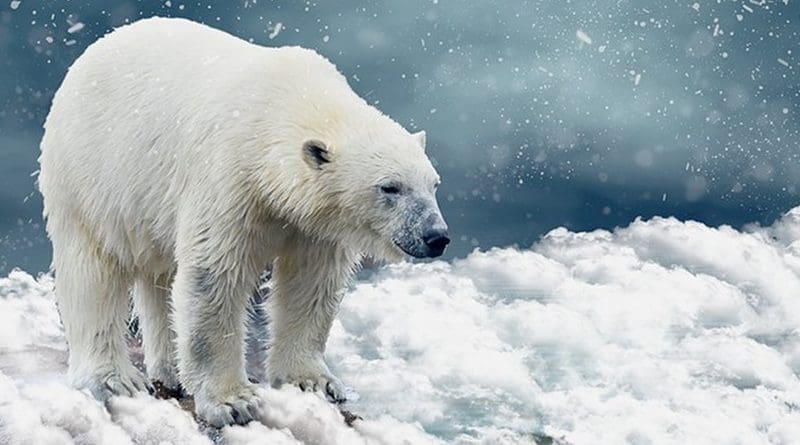How Species Form: What The Tangled History Of Polar Bear And Brown Bear Relations Tells Us
A new study is providing an enhanced look at the intertwined evolutionary histories of polar bears and brown bears.
Becoming separate species did not completely stop these animals from mating with each other. Scientists have known this for some time, but the new research draws on an expanded dataset — including DNA from an ancient polar bear tooth — to tease out more detail.
The story that emerges reveals complexities similar to those that complicate human evolutionary history.
“The formation and maintenance of species can be a messy process,” says Charlotte Lindqvist, PhD, associate professor of biological sciences in the University at Buffalo College of Arts and Sciences, and an expert on bear genetics. “What’s happened with polar bears and brown bears is a neat analog to what we’re learning about human evolution: that the splitting of species can be incomplete. As more and more ancient genomes have been recovered from ancient human populations, including Neanderthals and Denisovans, we’re seeing that there was multidirectional genetic mixing going on as different groups of archaic humans mated with ancestors of modern humans. Polar bears and brown bears are another system where you see this happening.”
“We find evidence for interbreeding between polar bears and brown bears that predates an ancient polar bear we studied,” she says. “And, moreover, our results demonstrate a complicated, intertwined evolutionary history among brown and polar bears, with the main direction of gene flow going into polar bears from brown bears. This inverts a hypothesis suggested by other researchers that gene flow has been unidirectional and going into brown bears around the peak of the last ice age.”
The study will be published the week of June 6 in the Proceedings of the National Academy of Sciences. It was led by Lindqvist at UB in the U.S.; Luis Herrera-Estrella at the National Laboratory of Genomics for Biodiversity (LANGEBIO) in Mexico and Texas Tech University in the U.S.; and Kalle Leppälä at the University of Oulu in Finland. Tianying Lan, PhD, a former UB postdoctoral researcher now at Daicel Arbor Biosciences, was co-first author with Leppälä.
The concept of Arctic-adapted polar bears capturing genetic material from brown bears, which are adapted to life in lower latitudes, is one of several findings of possible interest for scientists concerned with climate change impacts on threatened species.
As the world warms and Arctic sea ice declines, polar bears and brown bears may run into each other more frequently in places where their ranges overlap. This makes their shared evolutionary history a particularly intriguing subject of study, Lindqvist says.
Splitting of species can be a messy process
As Lindqvist explains, scientists once thought modern humans and Neanderthals simply split into separate species after evolving from a common ancestor. Then, researchers found Neanderthal DNA in modern Eurasian people, implying that modern human populations received an influx of genes from Neanderthals at some point in their shared evolutionary history, she says.
Only later did scientists realize that this genetic intermingling also supplemented Neanderthal populations with modern human genes, Lindqvist adds. In other words, interbreeding can be complex, not necessarily a one-way street, she says.
The new study on bears reveals a remarkably similar story: The analysis finds evidence of hybridization in both polar bear and brown bear genomes, with polar bears in particular carrying a strong signature of an influx of DNA from brown bears, researchers say. Earlier research proposed the inverse pattern only, Lindqvist says.
“It’s exciting how DNA can help reveal ancient life history. Gene flow direction is harder to determine than merely its presence, but these patterns are vital to understanding how past adaptations have transferred among species to give modern animals their current features,” says Leppälä, PhD, postdoctoral researcher in the research unit of mathematical sciences at the University of Oulu.
“Population genomics is an increasingly powerful toolbox to study plant and animal evolution and the effects of human activity and climate change on endangered species,” says Herrera-Estrella, PhD, President’s Distinguished Professor of Plant Genomics and director of the Institute of Genomics for Crop Abiotic Stress Tolerance in the Texas Tech Department of Plant and Soil Science. He is also a professor emeritus at LANGEBIO. “Bears don’t provide simple speciation stories any more than human evolution has. This new genomic research suggests that mammalian species groups can hide complicated evolutionary histories.”
Evidence from modern bear genomes — and DNA from an ancient tooth
The study analyzed the genomes of 64 modern polar and brown bears, including several new genomes from Alaska, a state where both species are found.
The team also produced a new, more complete genome for a polar bear that lived 115,000 to 130,000 years ago in Norway’s Svalbard archipelago. DNA for the ancient polar bear was extracted from a tooth attached to a subfossil jawbone, which is now housed at the Natural History Museum at the University of Oslo.
Using this dataset, researchers estimate that polar bears and brown bears started to become distinct species about 1.3 to 1.6 million years ago, updating prior assessments made by some of the same scientists. The age of the split has been and remains a topic of scientific debate, with past interbreeding and limited fossil evidence for ancient polar bears among factors that make the timing hard to pinpoint, Lindqvist says.
In any case: After becoming their own species, polar bears endured dramatic population decline and a prolonged genetic bottleneck, leaving these bears with much less genetic diversity than brown bears, the new study concludes. The findings confirm past research pointing to the same trends, and add evidence in support of this hypothesis.
Together with the analysis of gene flow, these findings are providing new insights into the messy, intertwined evolutionary history of polar bears and brown bears.

